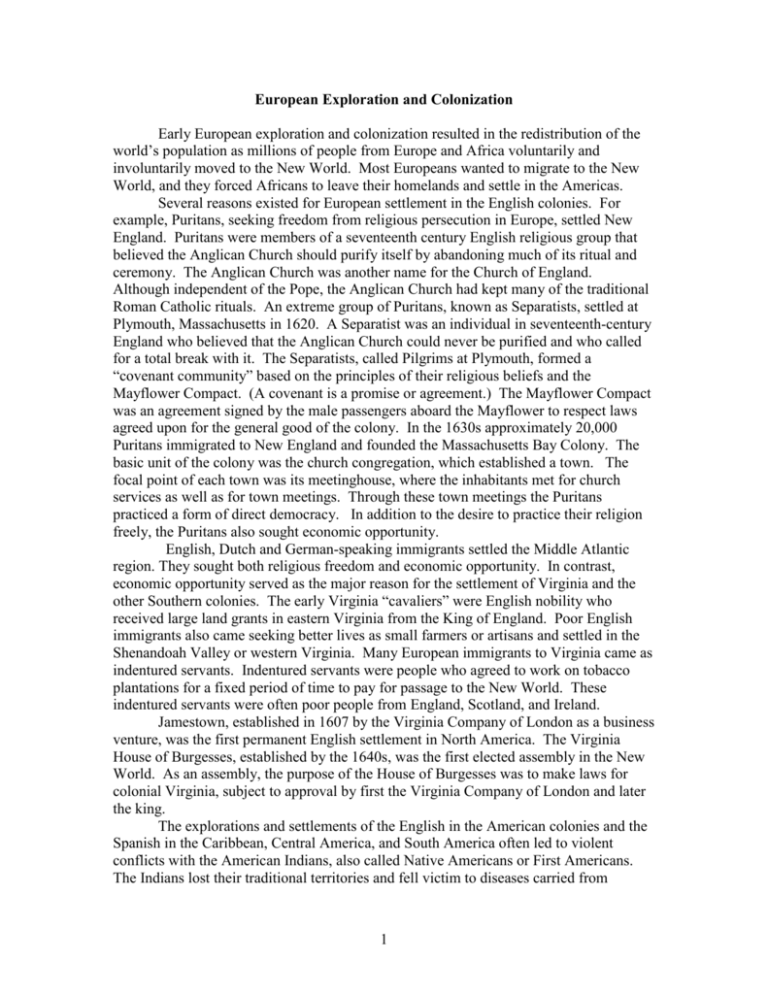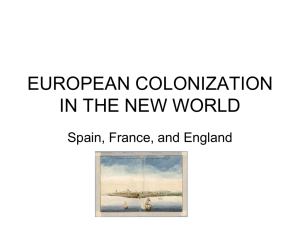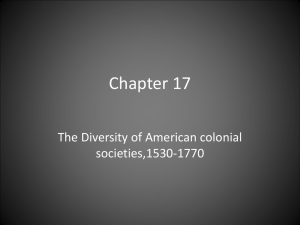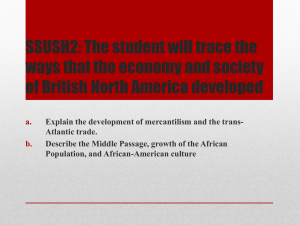VUS
advertisement

European Exploration and Colonization Early European exploration and colonization resulted in the redistribution of the world’s population as millions of people from Europe and Africa voluntarily and involuntarily moved to the New World. Most Europeans wanted to migrate to the New World, and they forced Africans to leave their homelands and settle in the Americas. Several reasons existed for European settlement in the English colonies. For example, Puritans, seeking freedom from religious persecution in Europe, settled New England. Puritans were members of a seventeenth century English religious group that believed the Anglican Church should purify itself by abandoning much of its ritual and ceremony. The Anglican Church was another name for the Church of England. Although independent of the Pope, the Anglican Church had kept many of the traditional Roman Catholic rituals. An extreme group of Puritans, known as Separatists, settled at Plymouth, Massachusetts in 1620. A Separatist was an individual in seventeenth-century England who believed that the Anglican Church could never be purified and who called for a total break with it. The Separatists, called Pilgrims at Plymouth, formed a “covenant community” based on the principles of their religious beliefs and the Mayflower Compact. (A covenant is a promise or agreement.) The Mayflower Compact was an agreement signed by the male passengers aboard the Mayflower to respect laws agreed upon for the general good of the colony. In the 1630s approximately 20,000 Puritans immigrated to New England and founded the Massachusetts Bay Colony. The basic unit of the colony was the church congregation, which established a town. The focal point of each town was its meetinghouse, where the inhabitants met for church services as well as for town meetings. Through these town meetings the Puritans practiced a form of direct democracy. In addition to the desire to practice their religion freely, the Puritans also sought economic opportunity. English, Dutch and German-speaking immigrants settled the Middle Atlantic region. They sought both religious freedom and economic opportunity. In contrast, economic opportunity served as the major reason for the settlement of Virginia and the other Southern colonies. The early Virginia “cavaliers” were English nobility who received large land grants in eastern Virginia from the King of England. Poor English immigrants also came seeking better lives as small farmers or artisans and settled in the Shenandoah Valley or western Virginia. Many European immigrants to Virginia came as indentured servants. Indentured servants were people who agreed to work on tobacco plantations for a fixed period of time to pay for passage to the New World. These indentured servants were often poor people from England, Scotland, and Ireland. Jamestown, established in 1607 by the Virginia Company of London as a business venture, was the first permanent English settlement in North America. The Virginia House of Burgesses, established by the 1640s, was the first elected assembly in the New World. As an assembly, the purpose of the House of Burgesses was to make laws for colonial Virginia, subject to approval by first the Virginia Company of London and later the king. The explorations and settlements of the English in the American colonies and the Spanish in the Caribbean, Central America, and South America often led to violent conflicts with the American Indians, also called Native Americans or First Americans. The Indians lost their traditional territories and fell victim to diseases carried from 1 Europe. By contrast, French exploration of Canada did not lead to large-scale immigration from France, and relations with native peoples were often more cooperative. The growth of an agricultural economy based on large landholdings in the Southern colonies and in the Caribbean Sea led to the introduction of African slavery in the New World. As a result, Europeans forced millions of Africans to come to the Americas against their will. The three regions of English settlement along the Atlantic coast developed distinct economic characteristics. The New England colonies developed an economy based on shipbuilding, fishing, lumbering, small-scale subsistence farming, and eventually, manufacturing. (Subsistence farming is growing only enough food to feed one’s family.) The New England colonies’ prosperity reflected the Puritans’ strong belief in the values of hard work and thrift. The middle colonies developed economies based on shipbuilding, small-scale farming, and trading. As a result, such cities as New York, Philadelphia, and Baltimore began to grow as seaports and commercial centers. Virginia and the other Southern colonies developed economies in the eastern coastal lowlands (tidewater) based on large plantations that grew “cash crops” such as tobacco, rice, and indigo for export to Europe. Virginia produced tobacco, while South Carolina produced rice and indigo. Farther inland, however, in the mountains and valleys of the Appalachian foothills, subsistence farming, hunting, and trading formed the basis of the economy of the Southern colonies. One should remember that a strong belief in private ownership of property and free enterprise characterized colonial life in all the English colonies of North America. The growth of a plantation-based agricultural economy in the hot, humid coastal lowlands of the Southern colonies required cheap labor on a large scale. Indentured servants met some of the labor needs, especially in Virginia. These servants were often poor persons from England, Scotland, or Ireland who agreed to work on plantations for a period of time in return for their passage from Europe or relief from debts. Most plantation labor needs eventually came to be filled by the forcible importation of Africans. While some Africans worked as indentured servants, earned their freedom, and lived as free citizens during the colonial era, over time larger and larger numbers of enslaved Africans were forcibly brought to the Southern colonies. In the triangular trade pattern between the New England colonies, the West Indies, and Africa, the Middle Passage was the leg between Africa and the West Indies. The development of a slaverybased agricultural economy in the Southern colonies would lead to eventual conflict between the North and the South and the American Civil War. Similarities and differences also existed in the social characteristics of the English colonies. New England’s colonial society was based on religious standing. The Puritans grew increasingly intolerant of dissenters who challenged the Puritans’ belief in the connection between religion and government. (Dissenters were people who disagreed with the dominant religion.) For example, dissenters, who fled persecution by Puritans in Massachusetts, founded the colony of Rhode Island. The middle colonies were home to multiple religious groups, including Quakers in Pennsylvania and Roman Catholics in Maryland, who generally believed in religious tolerance. These colonies had more flexible social structures and began to develop a middle class of skilled artisans, entrepreneurs (business owners), and small farmers. Virginia and the Southern colonies had a social structure based on family status and the ownership of land. Large 2 landowners in the eastern lowlands (tidewater) dominated colonial government and society and maintained an allegiance to the Church of England and closer social ties to England than in the other colonies. However, small subsistence farmers, hunters, and traders of Scotch-Irish and English descent comprised (made up) society in the mountains and valleys further inland. The “Great Awakening” was a religious movement that swept both Europe and the colonies during the mid-1700s. George Whitefield and Jonathan Edwards were two important preachers in this movement. They preached “fire and brimstone” sermons designed to make people recognize their sins and experience a new spiritual birth. The “Great Awakening” emphasized emotional spirituality and led to rapid growth in such new evangelical denominations (religious groups) as the Baptists and the Methodists. Since the Great Awakening challenged the established religious and governmental order, it laid one of the social foundations for the American Revolution. 3








